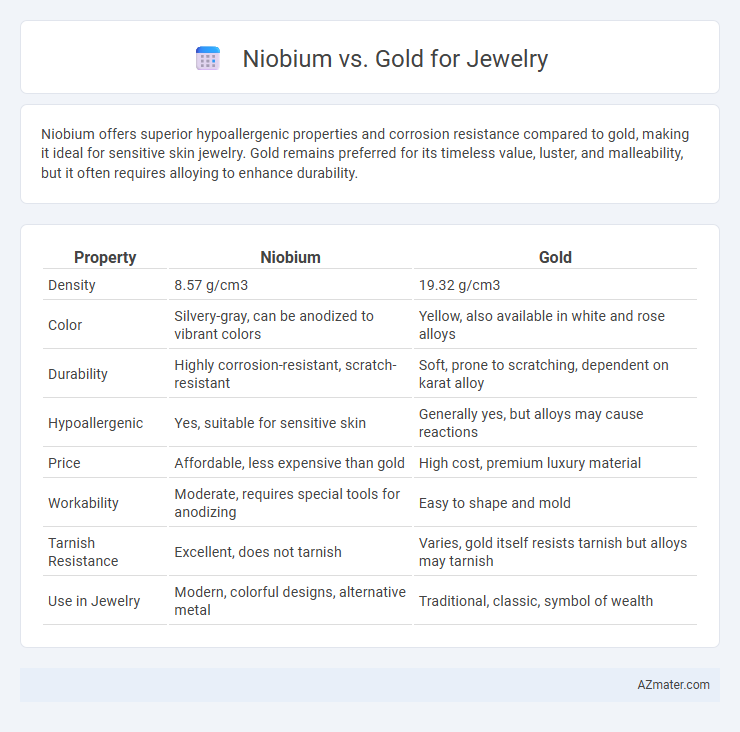Niobium offers superior hypoallergenic properties and corrosion resistance compared to gold, making it ideal for sensitive skin jewelry. Gold remains preferred for its timeless value, luster, and malleability, but it often requires alloying to enhance durability.
Table of Comparison
| Property | Niobium | Gold |
|---|---|---|
| Density | 8.57 g/cm3 | 19.32 g/cm3 |
| Color | Silvery-gray, can be anodized to vibrant colors | Yellow, also available in white and rose alloys |
| Durability | Highly corrosion-resistant, scratch-resistant | Soft, prone to scratching, dependent on karat alloy |
| Hypoallergenic | Yes, suitable for sensitive skin | Generally yes, but alloys may cause reactions |
| Price | Affordable, less expensive than gold | High cost, premium luxury material |
| Workability | Moderate, requires special tools for anodizing | Easy to shape and mold |
| Tarnish Resistance | Excellent, does not tarnish | Varies, gold itself resists tarnish but alloys may tarnish |
| Use in Jewelry | Modern, colorful designs, alternative metal | Traditional, classic, symbol of wealth |
Introduction to Niobium and Gold in Jewelry
Niobium and gold are popular metals in jewelry, each offering unique properties and aesthetic qualities. Niobium is prized for its hypoallergenic nature, vibrant color options through anodizing, and lightweight durability, making it ideal for sensitive skin and modern designs. Gold, valued for its timeless beauty, malleability, and intrinsic value, remains a classic choice in fine jewelry, often alloyed to enhance strength and color variety.
Physical Properties: Niobium vs Gold
Niobium exhibits greater hardness and excellent corrosion resistance compared to gold, making it highly durable for everyday jewelry wear. Gold is significantly denser and softer, which allows for intricate designs but is prone to scratches and deformation. Niobium's hypoallergenic properties and its ability to anodize in various colors offer unique aesthetic and functional advantages over traditional gold jewelry.
Color and Aesthetics Comparison
Niobium offers a unique advantage in jewelry with its ability to display a wide range of vibrant colors through anodization, including blues, purples, and greens, making it ideal for customized and artistic pieces. Gold, renowned for its classic warm yellow hue and available in variations like rose and white gold, delivers a timeless elegance and high-end appeal that remains unmatched in luxury jewelry. While gold provides a traditional and prestigious aesthetic, niobium's diverse color palette allows for innovative styles and a modern look in jewelry design.
Hypoallergenic Qualities and Skin Safety
Niobium stands out for its exceptional hypoallergenic properties, making it ideal for individuals with sensitive skin or metal allergies, as it rarely causes irritation or allergic reactions. Gold, particularly in higher karats like 18K or 24K, is generally safe for most skin types but can cause allergic reactions when alloyed with metals such as nickel or copper in lower karat versions. Niobium's resistance to oxidation and corrosion further enhances its skin safety, providing a durable and non-reactive option for hypoallergenic jewelry compared to some gold alloys.
Durability and Wear Resistance
Niobium offers exceptional durability and superior corrosion resistance compared to gold, making it highly resistant to scratches and tarnish over time. Gold, while prized for its luster, is softer and more prone to dents and wear, especially in lower karat forms. For jewelry that maintains structural integrity and appearance after daily wear, niobium presents a more resilient option than traditional gold alloys.
Cost and Affordability
Niobium offers a highly affordable alternative to gold in jewelry, with prices significantly lower due to its abundance and ease of production. Gold's cost remains substantially higher, driven by its rarity, market demand, and intrinsic value, making it a premium choice for investment-grade pieces. Consumers seeking budget-friendly, hypoallergenic options often prefer niobium for its cost-effectiveness without sacrificing durability or aesthetic appeal.
Design Versatility and Customization
Niobium offers exceptional design versatility and customization due to its ability to undergo anodization, creating a wide spectrum of vibrant colors without the use of dyes or plating, making each piece unique and hypoallergenic. Gold, prized for its timeless luster and malleability, allows intricate detailing and classic design styles but is more limited in color options unless alloyed. For jewelry designers seeking innovative color palettes and lightweight pieces, niobium provides unmatched flexibility, while gold remains the gold standard for luxury and traditional aesthetics.
Maintenance and Care Requirements
Niobium jewelry requires minimal maintenance due to its hypoallergenic properties and resistance to corrosion, making it ideal for sensitive skin and everyday wear without tarnishing. Gold jewelry, especially higher karats, demands regular cleaning and polishing to maintain its luster and can be prone to scratches and tarnishing over time. Both metals benefit from gentle cleaning solutions, but niobium's durability and resistance to discoloration significantly reduce the need for frequent care compared to gold.
Environmental Impact and Sourcing
Niobium offers a sustainable alternative to gold for jewelry due to its abundance and lower environmental footprint in extraction processes, producing fewer toxic byproducts and requiring less energy. Gold mining often involves extensive land disruption, water pollution, and the use of hazardous chemicals like cyanide and mercury, posing significant environmental and ethical challenges. Choosing niobium supports eco-friendly sourcing practices and reduces reliance on conflict-affected gold mining regions.
Choosing the Best Metal for Your Jewelry
Niobium offers exceptional hypoallergenic properties and vibrant anodized color options, making it ideal for sensitive skin and unique jewelry designs, while gold is valued for its classic luster, durability, and long-standing prestige. Choosing between niobium and gold depends on budget, desired aesthetic, and wearability, with niobium providing an affordable, lightweight alternative and gold representing traditional luxury and investment value. For those seeking versatile, skin-friendly metals, niobium excels, whereas gold remains the preferred choice for enduring elegance and resale potential.

Infographic: Niobium vs Gold for Jewelry
 azmater.com
azmater.com